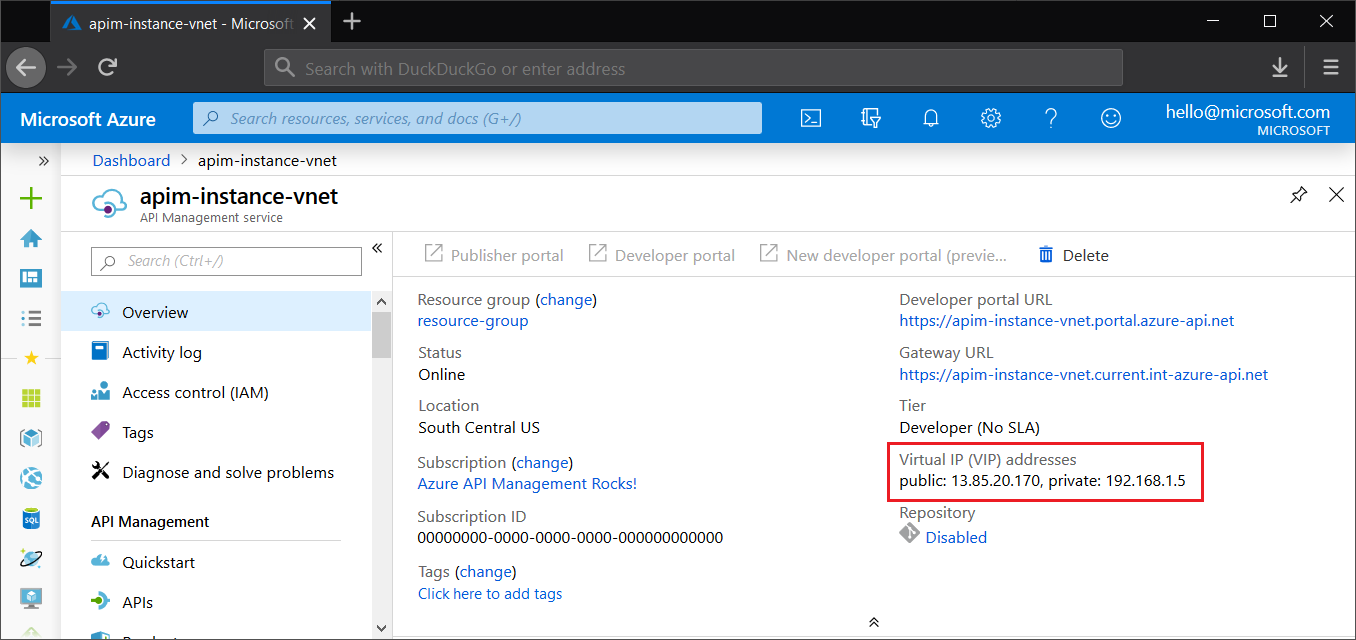Note
Access to this page requires authorization. You can try signing in or changing directories.
Access to this page requires authorization. You can try changing directories.
APPLIES TO: All API Management tiers
This article describes how to retrieve the IP addresses of Azure API Management. IP addresses can be public or private if the service is in a virtual network. You can use IP addresses to create firewall rules, filter incoming traffic to backend services, or restrict outbound traffic.
Public IP addresses
Every API Management instance in Developer, Basic, Standard, or Premium tier has public IP addresses that are exclusive only to that instance. (They're not shared with other resources.)
You can retrieve the IP addresses from the overview dashboard of your resource in the Azure portal:
You can also fetch them programmatically by using this API call:
GET https://management.chinacloudapi.cn/subscriptions/<subscription-id>/resourceGroups/<resource-group>/providers/Microsoft.ApiManagement/service/<service-name>?api-version=<api-version>
Public IP addresses will appear in the response:
{
...
"properties": {
...
"publicIPAddresses": [
"172.31.0.1"
],
...
}
...
}
In multi-regional deployments, each regional deployment has one public IP address.
IP addresses of API Management in a virtual network
If your API Management instance is inside a virtual network, it has two types of IP addresses: public and private.
Public IP addresses are used for internal communication, on port
3443, for managing configuration (for example, through Azure Resource Manager). In the external virtual network configuration, they're also used for runtime API traffic. In the internal virtual network configuration, public IP addresses are used only for Azure internal management operations and don't expose your instance to the internet.Private virtual IP (VIP) addresses, available only in internal virtual network mode, are used to connect from within the network to API Management endpoints: gateways, the developer portal, and the management plane for direct API access. You can use these addresses for setting up DNS records within the network.
You'll see addresses of both types in the Azure portal and in the response of an API call:
GET https://management.chinacloudapi.cn/subscriptions/<subscription-id>/resourceGroups/<resource-group>/providers/Microsoft.ApiManagement/service/<service-name>?api-version=<api-version>
{
...
"properties": {
...
"publicIPAddresses": [
"172.31.0.1"
],
"privateIPAddresses": [
"192.168.1.5"
],
...
},
...
}
Important
The private IP addresses of internal load balancer and API Management units are assigned dynamically. It's therefore impossible to anticipate the private IP of the API Management instance before its deployment. Additionally, changing to a different subnet and then returning might cause a change in the private IP address.
IP addresses for outbound traffic
API Management uses a public IP address for a connection outside the virtual network or a peered virtual network. It uses a private IP address for a connection in the virtual network or a peered virtual network.
When API Management is deployed in an external or internal virtual network and API Management connects to private (intranet-facing) backends, internal IP addresses (dynamic IP, or DIP, addresses) from the subnet are used for the runtime API traffic. When a request is sent from API Management to a private backend, a private IP address will be visible as the origin of the request.
Therefore, if IP restriction lists secure resources within the virtual network or a peered virtual network, we recommend that you use the whole API Management subnet range with an IP rule and (in internal mode) not just the private IP address associated with the API Management resource.
When a request is sent from API Management to a public (internet-facing) backend, a public IP address will always be visible as the origin of the request.
Changes to IP addresses
In the Developer, Basic, Standard, and Premium tiers of API Management, the public IP address or addresses (VIP) and private VIP addresses (if configured in the internal virtual network mode) are static for the lifetime of a service, with the following exceptions:
The API Management is deleted and then re-created.
The service subscription is disabled or warned (for example, for nonpayment) and then reinstated. Learn more about subscription states.
(Developer and Premium tiers) Azure Virtual Network is added to or removed from the service.
(Developer and Premium tiers) API Management is switched between external and internal virtual network deployment mode.
(Developer and Premium tiers) API Management is moved to a different subnet or configured with a different public IP address resource.
(Premium tier) Availability zones are enabled, added, or removed.
(Premium tier) In multi-regional deployments, the regional IP address changes if a region is vacated and then reinstated.
Important
When changing from an internal to external virtual network or changing subnets in the network, you can configure a different public IP address. If you don't provide one, an Azure-managed public IP address is automatically configured.

